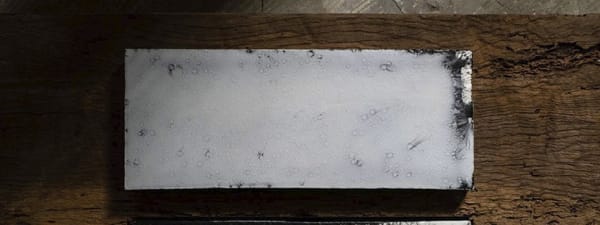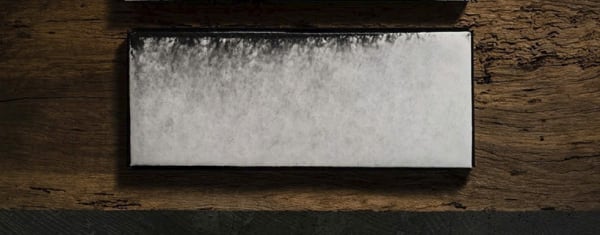Kwak Hye-young South Korean, b. 1982
Kwak is a South Korean artist who, through her conceptual practice, blurs the boundary between ceramics and fine art. Since her training at Sookmyung Women’s University, Kwak’s two-dimensional practice has faced challenge and raised valuable debate around the consideration of fine art and ceramics. Kwak made her international debut in 2018 with her poetic series ‘Seeing the Sounds of Rain’, which received an overwhelming response from respected international collectors and curators.
Through her work, the artist considers ideas of becoming and existence, following the fleeting moments of the rain as it emerges into life only as it falls, to its transformation and dissipation as it lands. Kwak interprets its sound as the voice of the invisible, announcing a brief presence in the world. To record this presence, the artist forms boards of clay layered with cobalt, chromium and iron oxide and places them in locations such as her own garden and the city streets of Seoul. The rain falls and as the drops land and combine they form rivulets, pools and washes, the movements all caught by the oxides and clay. Kwak maintains that the works are created by nature, and that she is merely a collaborator who enables but does not interrupt or affect the process of creation. To make the boards, Kwak purifies the clay through repeated filtering, before shaping and bisque firing, then applying the oxide layers. It is a challenging process as she patiently waits for the rain to both start and to cease allowing the water to affect the oxides. Kwak then meticulously moves the boards to retain the integrity of the marks. Each board is monitored as it dries over a month-long period before being fired again in the kiln. Throughout this meditative process, the artist finds a form of liberation, setting aside the artists ego, handing over the making to nature. Kwak suggests that this approach can also be taken up by viewers, liberating them from interpretation. The sensorial pull of the works however draws upon each of our own physical and mental associations of rain, offering time to appreciate our ephemeral relationship with this element of nature.
-
 See the Sound of Rain 018, 2016View more details
See the Sound of Rain 018, 2016View more details -
 Seeing the sound of rain 021, 2017View more details
Seeing the sound of rain 021, 2017View more details -
 Seeing the sound of rain 022, 2017View more details
Seeing the sound of rain 022, 2017View more details -
 Seeing the sound of rain 037, 2018View more details
Seeing the sound of rain 037, 2018View more details -
 Seeing the sound of rain 039, 2018View more details
Seeing the sound of rain 039, 2018View more details -
 Seeing the Sound of Rain_Spring and Summer in Seoul, 2018-2020View more details
Seeing the Sound of Rain_Spring and Summer in Seoul, 2018-2020View more details -
 Seeing the Sound of Rain_Spring and Summer in Seoul, 2018-2020View more details
Seeing the Sound of Rain_Spring and Summer in Seoul, 2018-2020View more details -
 Seeing the Sound of Rain_Spring & Summer in Seoul, 2018~2019View more details
Seeing the Sound of Rain_Spring & Summer in Seoul, 2018~2019View more details -
 Seeing the Sound of Rain 0929, 2021View more details
Seeing the Sound of Rain 0929, 2021View more details -
 Seeing the sound of rain 11107 (set of 4), 2021View more details
Seeing the sound of rain 11107 (set of 4), 2021View more details -
 Seeing the Sound of Rain 0630, 2022View more details
Seeing the Sound of Rain 0630, 2022View more details
-

Sounds of Spring
Exhibition 11 Apr - 10 May 2025Preview: 6-8pm, 10th April Venue: Dandi Battersea, Haydon Way, London SW11 1YF Opening Hours: Monday to Friday, 11am–6pm (Weekends by appointment) Sounds of Spring is a sensory-led exhibition that reflects on the quiet transitions of the season, presenting contemporary Korean artworks in conversation with antique furniture. Together, they form a...Read more -

Untold Beauty
Exhibition 16 - 24 Sep 2023Untold Beauty draws on a distinctive period in Korean craftsmanship refined during the Joseon dynasty (est 14c). Presenting works by contemporary practitioners, it explores the current return to Joseon’s contemplative aesthetic: featuring ceramics, furniture, textile, and woodworwk including the Moon Jar. Clean, non-decorative and functional everyday objects were made and...Read more -

Moon Jar ; The Untold Story
Exhibition 3 - 14 May 2023Lloyd Choi Gallery is delighted to announce 'Moon Jar; The Untold Story', a London Craft Week Exhibition, organised by Korea Craft & Design Foundation and curated by Lloyd Choi. The Moon Jar is a sculptural form that became an icon in contemporary ceramic history and is celebrated in both the...Read more -

Collect
Fair 1 - 5 Mar 2023For Collect 2023, Lloyd Choi Gallery will focus on the new generation of ceramic artists and introduce two European- based Korean artists, exhibiting in London for the first time. Yusun Won, living and working in Cardiff and Lydia SJ Park based in Oslo. Both have already achieved international recognition for...Read more -

Korean Blue
Exhibition 2 - 6 Nov 2022Unlike Yves Klein, the colour blue was a hue that meant home to the pioneering Korean painter Kim Whan-gi who moved to Paris in the 1950s and became the father of the Korean abstract art movement. Its purity, transparency and tranquillity reflect the virtue of Korean traditions that played a...Read more -

Silent Mind
Exhibition 14 - 25 Sep 2022The exhibition title reflects the calm and mindful status of the craft-artists Lloyd Choi Gallery works with, whose practices are hands-on and materials-led. These Korean artists and makers, working with natural materials, hold a focus on process and understanding the laws of nature – choosing to work with these, rather...Read more -

Artefact
Fair 10 - 15 May 2022Lloyd Choi Gallery is pleased to return to the ARTEFACT, a curated, boutique art fair for contemporary craft at the Design Centre, Chelsea Harbour in London (10 – 15 May 2022). Lloyd Choi Gallery will present exciting new artworks by our Korean young talents who are reinterpreting traditional materials and...Read more -

Kwak Hye-young's Personal Structure
Solo Presentation 23 Apr - 27 Nov 2022Lloyd Choi Gallery is thrilled to present Kwak Hey-young at Personal Structures 2022, the European Cultural Centre(ECC)'s contemporary art exhibition in parallel to the Venice Biennale 2022. Kwak Hye-young is a South Korean female artist who works with the rain to create abstract ceramic artworks to respond to this year's...Read more -

Collect
Fair 23 - 27 Feb 2022It is delightful to return to the international art fair, Collect at Somerset House in London. Alongside exciting new works by thirteen established Korean artists, Lloyd Choi Gallery is thrilled to present two new artists working at the heart of this new wave of craftsmanship. new artists working at the...Read more -

Artefact
Fair 22 - 29 Jun 2021It is thrilled to announce our participation at ARTEFACT, a new contemporary craft fair launching this summer at Design Centre , Chelsea Harbour. The gallery will present eight Korean established and emerging artists who are working with ceramics, metal, mother of pearl, wood and textiles. Visiting Information Design Centre Chelsea...Read more -

Material Dialogue
Exhibition 27 Feb - 15 Mar 2021Material Dialogue explores the conversations in craft: those between artist and materials, the materials themselves and between tradition and contemporary practice. In the realm of Korean tradition, the mastering of craft techniques is a meditational process that can only be achieved by emptying the conscious mind and understanding the materials'...Read more -

Collect
Fair 24 Feb - 2 Mar 2021For Collect 2021 online art fair, the gallery will present eleven Korean master craftsmen and established artists who are working with ceramics, metal, mother of pearl, natural lacquer, silver and textiles including two of Lowe Craft Prize 2020 finalists, silver artist Cho Sung-ho and Ottchil Natural Lacquer artist Park Sung-youl,...Read more -

Collect
Fair 27 Feb 2020 - 1 Mar 2021Lloyd Choi Gallery is thrill to launch at Collect and will present Korean contemporary artists who are crossingdisciplines of architecture, craft, design, fine art, painting, sculpture and textile to create fine art today in South Korea. The presentation will include a deconstructed Moon Jar by Lee Soo Jong – a...Read more

























